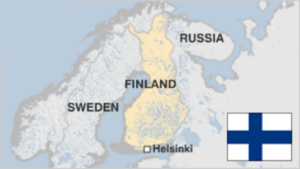This post is part of a series where I examine (which really means “read up on”) the economic and political development of the Scandinavian (or Nordic) nations from the end of WW2 to today, and summarize what I’ve learned into these blog posts.
Why am I doing this? Because the ongoing debate about “Scandinavian socialism” vs “Scandinavian capitalism” interests me. I’m curious for information devoid of ideological rhetoric.
If you found this post via an Internet search, it probably makes sense to start with the first post in this series, the link to which is both above, and here.
Table of Contents
A summary of major economic changes, 1945 to the present
Pre WW2
Finland was part of Sweden until 1809. Finland then became a Grand Duchy of Russia which lasted until 1917. During that time, Finland had broad economic autonomy.
In 1917 Finland became independent and largely sat out WW1 due to there being a civil war occurring inside Finland from January of 1918 to mid-May of 1918. The non-socialist Whites won against the socialist Reds.
WW2
Finland was not neutral during WW2 but had an unusual pattern of involvement which is sometimes described as “switching sides” but that seems to be an overly simplistic view.
When WW2 started, the Soviet Union demand access to a naval base in Finland (1939). Finland refused and this resulted in Finland going to war against the Soviet Union. Who was also at war with Germany. Finland very quickly lost this war and provided the territory the Soviet Union wanted on a 30-year lease (1940).
Finland then allowed the transit of German troops, as did formally neutral Sweden (1941).
As hostilities between Germany and the Soviet Union continued, Finland relaunched war against the Soviet Union (1941 to 1944), placing them on the side of Germany.
As Germany started to experience more defeats, more Finns started demanding peace in Finland. An armistice with the Soviet Union was signed (1944) which included a provision that all German troops leave Finland, which Germany refused to do.
In March of 1945, Finland declared war on Germany, placing them on the side of the Soviet Union, the UK, and the USA. However, since the war in Europe ended about two months later, this didn’t really mean much.
Immediate post WW2
Finland was considered to have been an ally of Germany during the war since for most of it, they were.
This resulted in an area of Finland being leased to the Soviet Union for a period of 50 years, and Finland agreeing to war reparations to the Soviet Union (1944). The amount was USD $300 million at 1938 prices, which is USD $5.52 billion at 2020 prices).
The reparations were not money but rather were paid in ships and machinery.
The amount was negotiated down a few years later, and Finland finished paying in 1952. The final payment was delivered in 340,000 railroad carloads.
Finish production rebounded quickly after the war. Industrial output exceeded prewar levels by the end of 1946, partly driven by the need to provide manufactured goods as part of the war reparations.
The Marshall plan
Finland declined to participate in the Marshall Plan so as not to antagonize the Soviet Union, to whom they were paying war reparations.
The influence of the Soviet Union
Finland was tied to the Soviet Union more than most European nations. A common border, war reparations, trade, etc allowed the Soviet Union to very strongly influence Finland.
As such, for fear of antagonizing the Soviet Union, Finland didn’t fully join western European nations until after the Soviet Union dissolved in 1991, by which time Germany had already started reunification.
The end of the cold war
After the Soviet Union dissolved in 1991, Finland was free to more fully integrate into the economies of western Europe.
Neoliberalism was late in coming to Finland, likely as a result of needing the ties to the Soviet Union to dissolve first. When it did, the customary deregulation of banking and finance led to a financialization of the economy, which supported the privatization of infrastructure and assets.
The global financial crisis
When the global financial crisis occurred in 2008, Finland could not depreciate their currency as once you surrender your sovereign currency (Finland adopted the euro in 2002), that’s no longer an option.
Finland experienced a credit expansion in the late1980s which led to the formation of asset bubbles (as they do) which burst in 1990. This led to an era of increased bank loan supervision, sometimes known as “better underwriting”, also known as “don’t make loans to people who can’t pay them back”.
The timing was good, as the credit expansion of the 2000s that led to the asset bubble collapse triggering the 2008 global financial crisis never quite got as out of hand in Finland as it did elsewhere.
As a result, Finland had fewer messes to clean up after the 2008 crash.
This allowed Finland to recover quicker than most eurozone nations, which was fortunate because having given up their sovereign currency they were very much at the mercy of the policies enacted by the European Central Bank.
International institutions
Finland joined the World Bank and the International Monetary Fund in 1948, joined GATT (the precursor to the World Trade Organization) in 1950, joined the United Nations in 1955, participated in NATO since 1994, joined the European Economic Area in 1992, and joined the European Union in 1995, and started using the euro in 2002, about three years after it was created.
The structure of the government of Finland
In the course of writing posts for this blog, I’ve read a fair amount of About pages on official government websites. Finland has by far the best terse explanation of what “government” is.
Government is a concept with several meanings. It may refer narrowly to the Government composed of the Prime Minister and the other ministers. It may also mean the broader organisational entity consisting of the ministries and the government plenary session format. It may at times refer only to the plenary session or to the ministers collectively. Usually it is clear from the context in which sense the term Government is used.
The current Finnish Government comprises 12 ministries. Each ministry is responsible for the preparation of matters within its mandate and for the proper functioning of administration.
About the Government. (2022). Valtioneuvosto. https://valtioneuvosto.fi/en/government
However, the definition of government on that page is narrower than I generally use, as it describes only executive functions, which technically speaking, is “the government” within a parliamentary democracy.
I would say that Finland is a parliamentary republic with a popularly elected president, who serves mostly ceremonial roles for a term of six years, and a prime minister who forms the government with their cabinet.
The main division of labour between the president and the prime minister seems to be external focus (president) vs internal focus (prime minister).
The president is responsible for Finland’s foreign policy and is the head of the Finnish Defence Force. The prime minister runs the executive functions of government.
When Finland became independent from Russia in 1917, they thought monarchy might be a good idea. It lasted 66 days (9 October 1918 to 14 Dec 1918) and stopped when the elected king renouced his throne.
The Finnish legislature has a single chamber which consits of 200 members which are elected every four years.
The executive functions are carried out by the Prime Minister, who is appointed by the president based on the vote in the latest parliamentary election, and their cabinet and their staff. Generally the leader of the party holding the most seats in parliament becomes the prime minister.
The third branch of government is the judiciary, which is described more below.
The political climate
Maybe I’m a little weird, but my favourite recent news story about politics in Findland is how the Prime Minister issued an apology after clubbing until 4 am after being informed she was in close proximity to someone (her foreign minister) who was known to have Covid.
She was initially told it was safe for her to be around others as she was vaccinated, then she missed the text telling her it was not, because she had left her work phone at home.
First, if she thinks she MIGHT be infected but can not infect others because she’s vaccinated, she clearly does not understand the basic principles of how vaccines work.
But “left her work phone at home”?
At first, I thought this was a joke, then I thought it must be an intentional bad excuse to justify her poor judgement, but apparently, it’s true.
The head of the Finnish government, who, like all heads of government, is on call 24×7 every day, could not be reached, because she forgot her phone. I mean “WTF?” – is this a Finnish thing? Or has this happened elsewhere?
Anway, on a less petty note….
Finland is just another Nordic country built on regulated markets and a strong social safety net. As such, by the standards of many, they’re very liberal or left leaning, as are the other Nordic countries.
Finland has a long history of coalition governments, represented by parties of opposing ideologies. Right now, the left wing party Social Democratic Party holds 40 of the 200 seats in parliament, while the right wing Finns Party holds 38.
Finland has 22 registered political parties, 10 of which hold seats in the current Finnish parliament and the European parliament.
The business sector
The Heritage Foundation, which ranks nations according to what they call economic freedom, ranks Findland as the 12th freest economy on earth, out of 178 countries ranked.
The World Bank maintains a DoingBusiness profile on 190 countries, where they measure business regulations for local firms. They rank Finland high except for two areas: enforcing contracts and resolving insolvency, which interestingly is what they also ding Norway and Iceland for.
Trade unions
65% of workers in Finland belong to a trade union, the 2nd lowest of the five Scandinavian countries.
Government corruption
Transparency International, a global organization that ranks public sector corruption, gives Finland a Corruption Perceptions Index rank of 3, which ranks Finland the 3rd least corrupt government out of 180 nations ranked.
The legal system
Finland has an interesting dual court system.
The general courts hear civil and criminal cases, and administrative courts (the interesting part) review the action of public authorities on appeals filed by private individuals and corporations.
The general courts are organized into the usual three tiers: cases start in district courts, appeals are heard in the appeals court, and above it all sits the supreme court.
The administrative courts have two tiers: administrative courts and the supreme administrative court.
The only other country where I’ve stumbled across a court system for specifically hearing cases of alledged public official misconduct is Taiwan. Personally I think this is a great feature for a judiciary, and now I’m wondering how common this is, and how come neither the USA nor Canada has this feature.
The banking system
Finland is the only Nordic country in the eurozone, and this creates what to me is an interesting “distortion” in their banking system, which I confess I do not fully understand.
I’m accustomed to a national treasury and a national central bank operating according to rules established by their national legislature, and there being a 1 to 1 to 1 correspondence between them.
To the best of my knowledge, the only place on earth this is not true is within the eurozone. Each of the 19 eurozone nations has their national legislature, national treasury, and national central bank. Above all this is the European Central Bank and the intra Europe legislature (the European Parliament), but there is no european treasury.
There must therefore be a division of responsibility between the european central bank and the 19 national central banks, and this is the part I don’t understand.
Each of the 19 eurozone national treasuries can issue government bonds, and this is conceptually no different from how American states and Canadian provinces do so, but American states and Canadian provinces have no central bank.
Anyway, enough of what I don’t know.
The Finnish banking system includes government banks, commercial banks, savings banks, cooperative banks, and branches of foreign banks.
The the central is the Bank of Finland, which as stated above, must have some responsibility, with the European Central Bank, and the other 18 national central banks, for the monetary policy within the eurozone.
There are two government banks, the Bank of Finland, and the Nordic Investment Bank, which is an international bank owned by the NIB member nations (Denmark, Estonia, Finland, Iceland, Latvia, Lithuania, Norway, and Sweden). The NIB only does long-term loans for private and public projects.
The commercial banks provide a standard set of commercial banking services: deposits, retail loans, etc.
The Finnish Savings Bank group is a set of 40 savings bank, operating independently from each other, with a common origin and set of operating policies. They serve regional clients.
The cooperative banks are like the coops that used to be relativly plentiful in the USA and Canada. They are small independent banks that are owned by the depositors.
Foreign banks are simply braches of banks headquartered in other countries, such as CitiBank.
Government regulation of the economy
Like the other Nordic nations, and to a certain extent like all nations, the economy of Finland is managed, and in the case of Finland rather proactively, by the legislature, who sets the rules for the economy.
They are by no means laissez-faire in the regulation of their prosperous economy.
Taxation
Like other Scandinavian countries, Finland has higher taxes than the USA.
Here are the personal income tax rates for 2022 for Finish nationals:
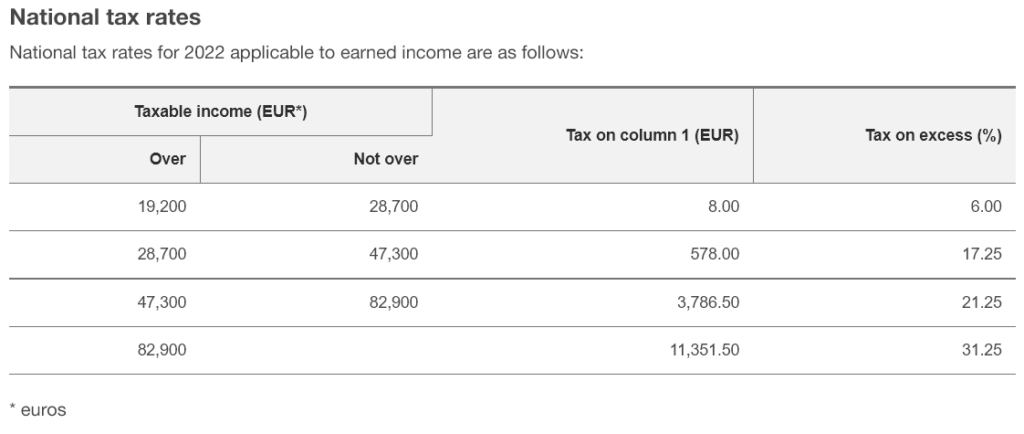
Local taxes are a flat rate that varies between 16.5% and 23.5% depending on the local municipality.
There is a church tax of between 1% and 2.2% depending on the parish.
There is a public broadcasting tax of 2.5% on annual income above 14,440 euros that is capped at 163 euros.
They also have a “foreign expert” income tax levied on foreign experts working in Finland and earning in excess of 5,800 euros per month from Finnish sources. It is a flat tax of 32%. If the foreign expert is already a resident of Finland, this tax does not apply.
Non-residents pay income tax only on Finnish sourced income, and rates are 35% on income and 30% on dividends.
Finland also has a 24% Value Added Tax on most goods, although it’s 14% for food, animal feed, restaurants, and catering services, and 10% for certain goods and services such as books, newspaper and magazine subscriptions, and passenger transport.
Finland has no wealth taxes.
Finland does have inheritance taxes which top out at 19% on the amount of the inheritances in excess of one million euros.
As you can see from the chart below sources of tax revenue for Finland rely on individual taxes more and corporate taxes less than other OECD nations.

Healthcare
In Finland, healthcare is financed at the level of the municipality, not by the central government. This makes sense since Finland does not have a sovereign currency but instead uses the euro.
Healthcare is divided into primary health care and specialized health care. Primary care is provided at municipal health services. Specialized care is provided mostly at hospitals. Some rare conditions are only treated at one hospital or healthcare unit. An example is pediatric congenital heart diseases are treated at the Helsinki University Central Hospital.
Private healthcare exists and about one-quarter of all health care services in Finland are provided by private companies, independent practitioners, etc.
Education
The education system in Finland is rated as the best in the world.
Finns consider education to be one of the cornerstones of the Finnish welfare state. From primary school to higher education, there are no fees.
Becoming a teacher in Finland is not easy. In Finland, it’s easier to become a doctor or a lawyer than it is to become a teacher.
Natural resources
The natural resources of Finland are mostly trees (three-fourths of Finland is forest) and minerals (copper, iron ore, nickel, cobalt, and chromium).
Freshwater (Finland is known as the “land of a thousand lakes”) and freshwater fishing contribute.
As well as hydroelectricity which is generated on many of the larger rivers.
Finland is also self-sufficient in agriculture, despite the long winters.
Direct government support and intervention
In a word, yes. Which is similar to the other Nordic nations. The laws of Finland support trade unions, a strong welfare state including universal healthcare and universal education, as well as low corporate taxes.
As stated earlier, no one could ever confuse Finland (or any of the Nordic countries) as having laissez-faire economic policies.
Foreign direct investment
The World Bank Group Doing Business rating dings Finland for the same things they ding all the Nordic countries: enforcing contracts and resolving insolvency.
They rank Finland 20th out of 190 countries and in the chart below you see highly fluctuating levels of foreign direct investment which started around 1991. I’m not sure why the fluctuations are so large.
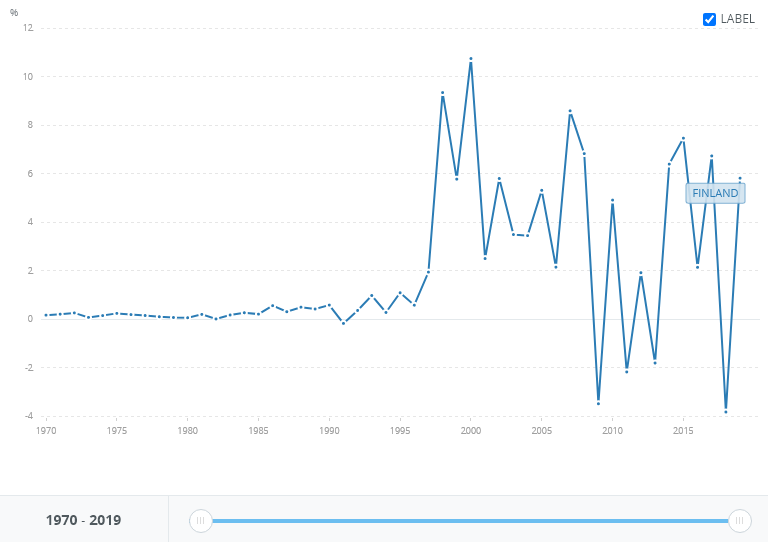
Important intra and inter country partnerships
Very similar to all the other Nordic countries. The government is heavily involved in managing the economy, strong trade unions are supported by the laws of Finland, and there is a Nordic style (generous by the standards of most countries) welfare state, which they pay for with higher taxes.
GDP by sector
The chart below looks very like the other Nordic nations whose economies are dominated by services. In the case of Finland, their agricultural sector is smaller and their industrial sector is larger.

The balance of trade
Finland ran a positive trade balance from 1992 to 2012, and since then has run slightly negative, in the range of -1% to -2%.
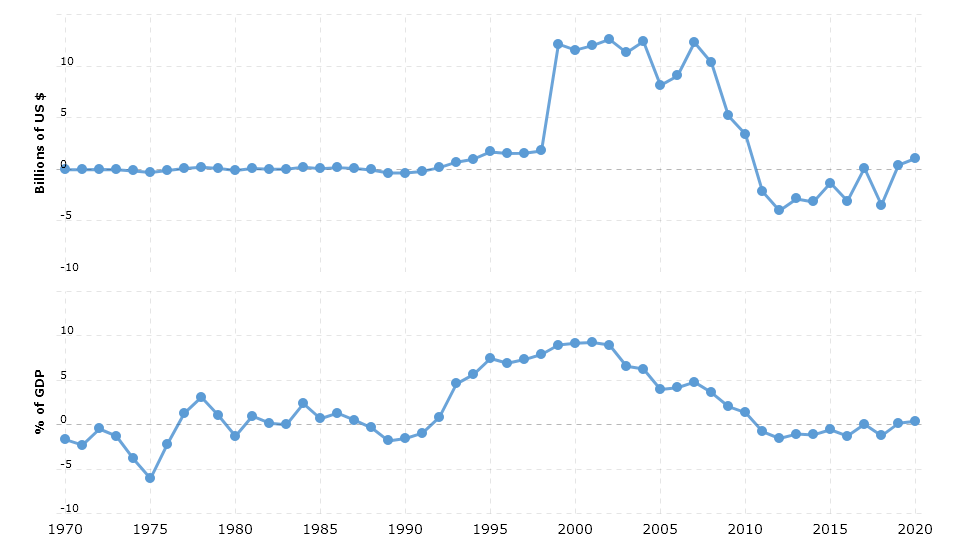
I was curious to learn more about that positive trade balance “blip”, so I searched and found the chart below, which indicates it wasn’t one type of good.
Currency change maybe? No, since Finland adopted the euro in 2002, in the middle of that blip. I am curious why the graph has the blip from 1992 to 2012, so if you know, please let me know.
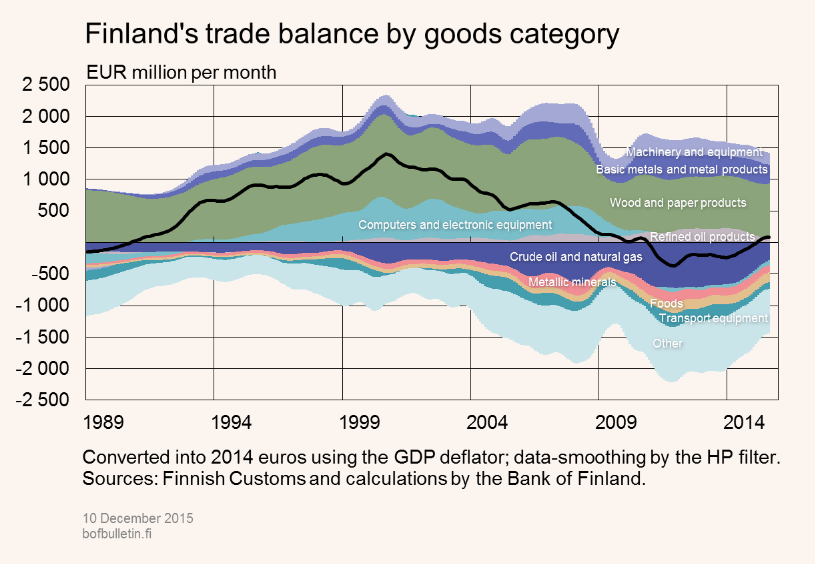
Exports by sector
You can see the high reliance on forestry products in the chart below. I was also surprised to find that machinery was such a large part of Finnish exports, but I guess after the Soviet Union kind of forced them to direct their economy towards manufacturing, it had residual effects that are felt to this day.
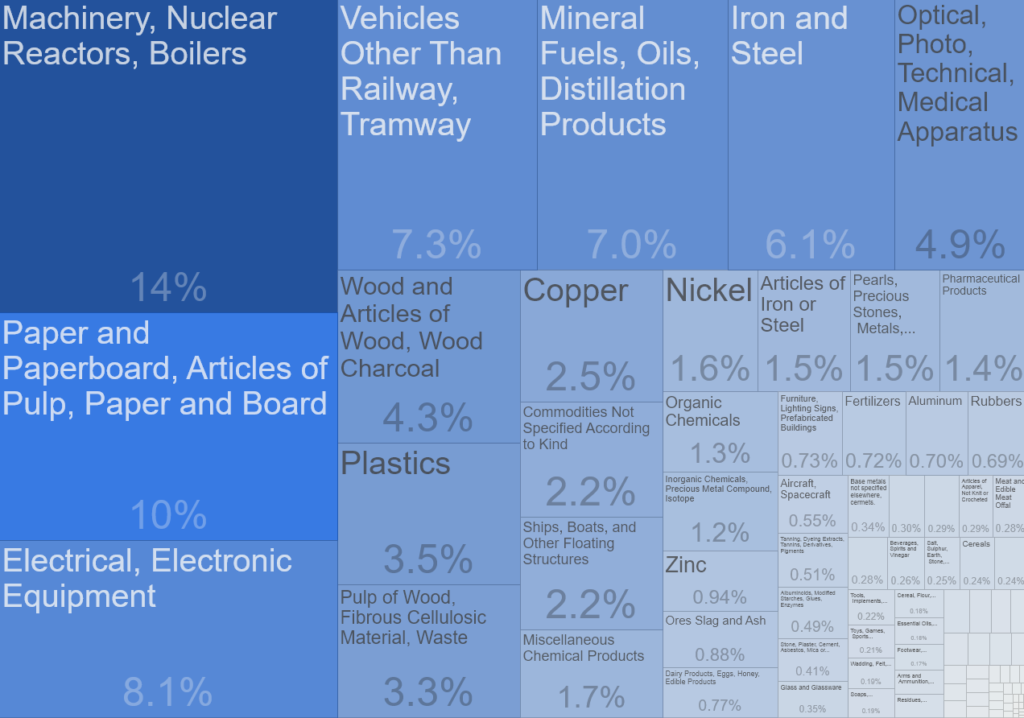
Wealth and income inequality
The most widely used measure of income distribution is the Gini index. It condenses several data points into a single number from 0 (perfect equality) to 1 (perfect inequality), although it is sometimes expressed as a number between 0 and 100.
The Gini value for Finland for 2018 (the most recent year the World Bank website provides a value for) was 27.3, which is one of the more equal economies on earth. Finland had a pretty significant dip in inequality in 2014, but it lasted only one year.
